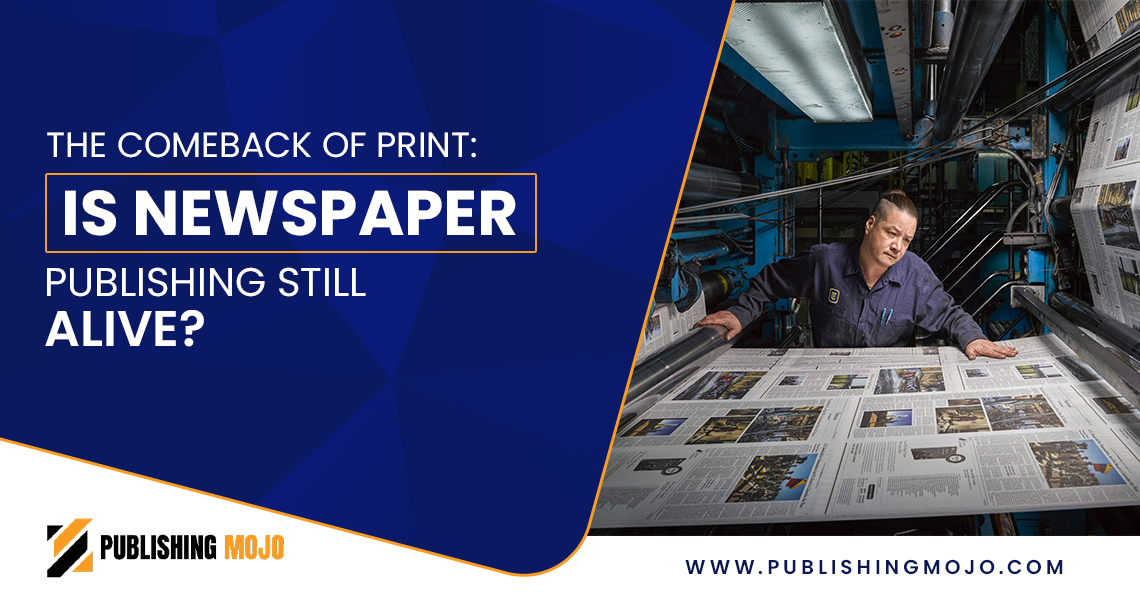While print
newspapers have faced a decline in recent years, they are not dying out. People
are restoring print media and digital newspaper publishing. Besides, a longing
for tactile options is driving this shift.
The appeal of print and
its power to offer in-depth insights and long-form stories is vital to its constant
value.
A Changing Media Landscape
Today, there is a decline in newspapers in the digital age. This is due to changing reading habits and the rise of online news platforms. While newspaper publishing still exists, its sharing and impact have plunged. This is mainly due to online news sharing platforms.
Online news and the shift towards mobile device use are growing. This is changing the news landscape. Instant access to news and distinct content is also driving this shift.
Mobile devices are a strong means today. They help access online news.
Despite The Digital Wave, Print Is Not Dead
While digital media has become strong, print is not dead; it is changing to offer unique value that digital media cannot match. The print retains a solid source. Besides, the unique power of newspaper writing to target precise users makes it a useful option. As a result, people are inclined to get articles published in newspapers today.
In This Article!
This article will explore the value of print and newspaper publishing in today’s age. It will also share how digital newspaper publishing is helping drive success in today’s landscape.
From Headlines to Hashtags: A History of Shifting Media
The golden era of newspaper publishing saw print newspapers rule as news and data sources. This era was marked by the growth of newspaper writing and digital progress. This changed public views and culture.
The weight of print during this time was strong. As a result, the impact of newspaper writing was seen in education and political discourse.
The rise of 24-hour news cycles, social media, and online media has deranged standard news options. Besides, it has created new options for data use and sharing. This shift has changed how we gather, share, and consume news. It has also changed how we can get articles published in newspapers. Besides, it has altered common journalism, business models, and public discourse.
The rise of online media has changed newspaper publishers. This has reduced readership and returns. Newspapers face high costs, lower budgets, and fewer readers. As a result, they have reduced printing or moved to online options.
The shift to online news options has further boosted this trend.
Why Some Stories Still Belong on Paper
Reading a physical newspaper offers a sensory experience. This goes beyond the visual, engaging touch. When you get an article published in the newspaper, it offers a tactile feel to readers, which is absent in online options. As a result, it connects them more deeply with the content.
When you get an article published in a newspaper, it acts as a solid link to the world. Besides, it offers a unique feel that is more engaging than digital newspaper publishing.
Long-form journalism and investigative pieces thrive in print media. Besides, they help get articles published in the newspaper.
You can find long-form journalism in The New York Times, Rolling Stone, and The New Yorker. These forms are known for their high-impact features.
Printed journalism enjoys higher value and trust than click-driven online content. This is mainly related to mainstream news sources. While online content can be trusted, the focus on clicks and engagement can harm the value of news sharing.
Many people love the feel of a newspaper. Besides, they prefer to read at their own pace rather than move through online content.
The Rise of Niche and Local Print Publications
Hyper-local newspapers and community-driven news sharing are thriving, mostly online. Besides, people seek local news and data. A shift towards online platforms drives this growth. Hyperlocal news outlets offer detailed reporting and real-time updates. As a result, they engage more people.
Small publishers are revamping newspaper writing for precise users. They are focusing on local news and using online platforms. Besides, they are keeping the value of sponsored content. They are also sailing through the changing landscape of local news. This is helping them engage more people and win their trust. This is also helping them find ways to retain their value. As a result, they can publish stories in newspapers in the face of new tactics.
The focus on regional storytelling is growing. It portrays a broader trend of local stories. This trend is also due to the growing impact of stories on cultural value. Besides, people are working to publish stories in newspapers.
Digital Synergy: When Print and Pixels Coexist
Modern newspaper publishers are using digital and print. They are adapting print rules to digital design. Besides, they are forming a robust online presence. They are also using online platforms to reach new viewers while keeping the value of newspaper publishing.
Modern newspaper publishers are upgrading their websites for a good user feel. Besides, they are adding online stories. They are also sharing free and premium online content.
Hybrid options, like paywalls, e-editions, and print-on-demand, are common. They use diverse means to share and monetize their content.
Paywalls limit access to content. E-editions offer unique versions of digital newspaper publishing. Print-on-demand creates products on demand.
Paywalls are common in fields like newspaper publishing. They restrict access to premium content or features unless users pay for a subscription or purchase. This approach can be metered, where some articles are free of charge. It can also be a complete paywall with locked content.
E-editions are unique versions of online news options. They are simple to access for people. This includes digital newspapers and books.
In print-on-demand, you can print and fulfill products when someone places an order. This allows firms to offer more products. Besides, it makes it a great choice for crafting custom items.
Newsletters and social media work drive traffic to both platforms. Newsletters can highlight social media posts and urge people to join the group. Social media can promote newsletters and tease snippets of their content. This engages more viewers. It also boosts the presence of both channels.
Getting Published in Today’s Hybrid Ecosystem
To publish a story in the newspaper, you can use modern print and digital options. Newspaper publishing helps gather content and manage pre-press, press, and post-press options. Digital newspaper publishing can take the form of online versions of printed news or stand-alone online options.
In both digital and print options, editors focus on high-quality content that aligns with the outlet’s goals. They seek clear and concise content. They will publish a story in the newspaper that follows guidelines and ethical standards.
Editors assess the value of the script for newspaper publishing. Besides, they may reject it if it does not meet standards.
To publish a story in the newspaper, freelance writers and citizen journalists can target relevant outlets. They can also form a strong online presence and seek newspaper writing prospects. Besides, they can craft strong pitches and showcase their work using platforms.
Reviving Print as a Statement, not a Strategy
Newspapers focus on detailed reporting and quality outcomes. This is a form of slow journalism in a world full of data. Besides, the approach contrasts with the noise of many online news sources. It also focuses on researched, correct, and ethical data.
The appeal of print as a unique product is growing. It stems from its unique appeal in a digital world. Print offers a unique feel and a break from screen fatigue. Besides, it offers a sense of permanence that connects with people. This includes print ads, where the lasting impact of an ad is stronger with a brand than fleeting digital ads.
Luxury publishing is based on the niche appeal of fashion, travel, and design. These are gaining fame due to their high-quality content. Besides, they appeal to more people.
Publishing options like Vogue and Harper's Bazaar are strong. Besides, newspaper publishers use them to focus on high-fashion, runway shows, and luxury brands.
National Geographic and Scientific American appeal to people who love science and nature. Besides, newspaper publishers often feature decent images and content in these options.
While online media rules the news space, print retains a niche for those who value its unique traits. Print is using its strengths in content and format to reach more people.
Final word: The Next Chapter in Newspaper Publishing
Newspaper publishing has adapted to the digital age. It offers online versions of content, adding video and unique features. It also uses social media. While print sharing has declined, many newspapers exist and thrive online. Besides, they reach more people as they adapt to the changing landscape.
Digital and print media do not compete. They can coexist and support each other. This creates a stronger media landscape. Print offers unique value and a tactile feel that digital cannot mimic. However, digital provides easy access and real-time news updates. By using the strengths of both, you can craft unique and distinct feels for viewers.
Storytelling finds its home in the spaces where it connects, whether on screen or on paper. This happens when the stories align with their values and views. This helps create a strong and lasting bond with viewers.
FAQs
How does the newspaper publishing
process work?
The newspaper publishing process involves both editorial and manufacturing stages. The editorial process encompasses gathering news, writing stories, and editing them for accuracy and clarity. The manufacturing process involves typesetting, adding images, laying out pages, and finally, printing the newspaper.
Can individuals publish
their own newspapers?
Yes, individuals can publish newspapers, but there are typically legal and practical considerations to keep in mind. Beyond legal aspects, individuals would need to consider printing and distribution methods, and potentially, how to ensure their content is accessible and engaging to a desired audience.
What types of content
are published in newspapers?
Newspapers publish a wide range of content, including news articles, opinion pieces, advertisements, features, and more. They also often include visual elements like photos, illustrations, infographics, and comics.




